Start Licensing’s Ian Downes finds some good examples this week of how licensing can play a significant part in the retail re-invention.
I think we would all agree an essential feature of the licensing business is retail. Retail relationships and engagement are more important than ever before.
With this in mind, I have been noticing recently that there are subtle shifts in the retail landscape. I am not sure I can describe it as a trend, but a shift I have noticed are more examples of retailers partnering with other retailers. From the outside it isn’t always clear what the deal is and what are the dynamics behind this activity, but there seems to be an increasing amount of retail blending going on. I noticed a few more examples of this last week.
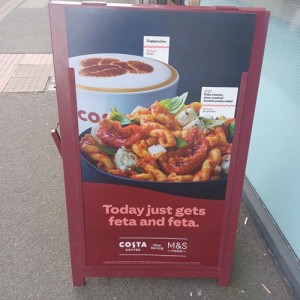 First I saw that coffee chain Costa Coffee is now serving M&S food in-store. I think previously it was selling its own products. Working with M&S gives it access to a wider range of proven products and also it is leaning on M&S’ reputation and awareness among consumers.
First I saw that coffee chain Costa Coffee is now serving M&S food in-store. I think previously it was selling its own products. Working with M&S gives it access to a wider range of proven products and also it is leaning on M&S’ reputation and awareness among consumers.
M&S is a strong high street brand. This has a real value in a competitive marketplace. M&S and M&S Food would, I imagine, score highly in terms of trust and product appeal for consumers. For M&S it takes their brand and product out of its own stores and into new store locations. Costa Coffee is the UK’s largest coffee chain and has around 2,500 outlets. This partnership also allows M&S to be part of the coffee shop ‘revolution’ beyond its own retail estate.
The initiative was launched in March and features 33 of M&S’ products including, reassuringly, Percy Pigs. Percy has become a flagbearer for M&S and deserves his place on the Costa roster. At the time of the launch, M&S’ Stuart Machin was quoted as saying “bringing together delicious, great quality M&S Food and the nation’s largest chain of coffee shops is great for customers as it extends our reach and supports our strategy of making M&S more relevant, more often for families”.
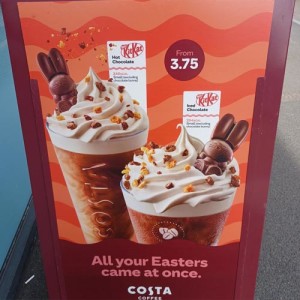 Interestingly Costa Coffee also uses brand collaborations to supplement its product offer. It teams up with brands from categories like confectionery and chocolate to add to its everyday roster. For Easter this year, it developed hot chocolate and iced chocolate drinks that included a Kit Kat chocolate bunny. A clever way of using a much loved brand and also a clever way of adding some seasonal variety to its menu. This promotion was flagged up on an advertising board outside the coffee shop.
Interestingly Costa Coffee also uses brand collaborations to supplement its product offer. It teams up with brands from categories like confectionery and chocolate to add to its everyday roster. For Easter this year, it developed hot chocolate and iced chocolate drinks that included a Kit Kat chocolate bunny. A clever way of using a much loved brand and also a clever way of adding some seasonal variety to its menu. This promotion was flagged up on an advertising board outside the coffee shop.
An old school technique to promote a product. Part of its purpose being to get people into store and to influence their buying decision. Selling coffee is a competitive business and these kind of special edition products can sway a consumer’s coffee choice.
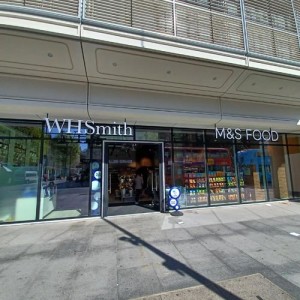 Another example of retail blending I saw also involved M&S. I noticed a new store opening on Tottenham Court Road which featured dual billing of M&S Food and WH Smith. The shop space was shared, with each partner retaining a distinct look and product offering.
Another example of retail blending I saw also involved M&S. I noticed a new store opening on Tottenham Court Road which featured dual billing of M&S Food and WH Smith. The shop space was shared, with each partner retaining a distinct look and product offering.
I guess this style of convenience store has been developed for locations like Tottenham Court Road which has footfall from students, tourists and local workers including hospital staff.
The shop covers most essential basics (I seem to recall it even has a Costa Coffee station in-store) and plays to both retailers’ strengths. I guess they share costs and can work in a joined up way. It is an attractive retail hub that has been crafted to suit the area. It will be interesting to see how it performs.
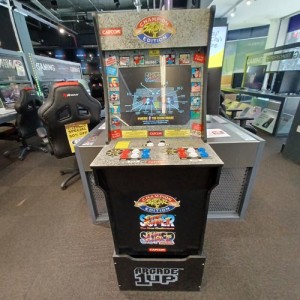 Traditionally, Tottenham Court Road was the go to London shopping street for consumer electronics. I seem to remember loads of shops side by side selling items like computers and hi-fis in the 1980s and 1990s. It was a very competitive retail environment. There are less stores of this kind now – maybe online retail and higher rents have played a part in reshaping the street.
Traditionally, Tottenham Court Road was the go to London shopping street for consumer electronics. I seem to remember loads of shops side by side selling items like computers and hi-fis in the 1980s and 1990s. It was a very competitive retail environment. There are less stores of this kind now – maybe online retail and higher rents have played a part in reshaping the street.
However there are still stores like Currys on the street. This branch is a supersized one, stretching back quite a long way. The first thing I noticed was that it was selling retro arcade games – it had a Streetfighter and Pac-Man versions on sale produced by Arcade 1 Up. A real blast from the past, but a very visual reminder of the power of gaming but also its longevity in the market. It is an entertainment category that has been around for some time now and is, of course, growing all the time in importance. Brands like Pac-Man are now classic properties.
Currys sells a broad range of products including printers and cartridges. In this category it was interesting to see Usain Bolt being used to sell Epson printers and printer ink. The strapline for this campaign was ‘Just Fill and Chill’. Always interesting to see personalities being used to sell products, not least thinking about the link between them and the product. I didn’t study this one too long, but I am hoping that the Epson range that Usain is promoting is perhaps the fastest printer on the market. The fixture certainly stood out in a busy shop so at that basic level Usain has done his job.
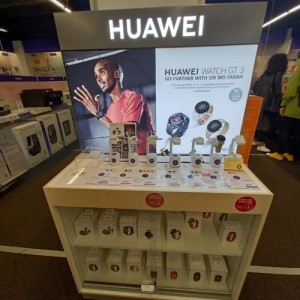 Usain wasn’t the only athlete on parade though. We moved from 100 metres to the marathon in a matter of yards at Currys, as not far from Usain I saw Sir Mo Farah being used to market Huawei smart watches. Given this is a performance watch and useful for runners, the link with Sir Mo was a good one and again the fixture stood out.
Usain wasn’t the only athlete on parade though. We moved from 100 metres to the marathon in a matter of yards at Currys, as not far from Usain I saw Sir Mo Farah being used to market Huawei smart watches. Given this is a performance watch and useful for runners, the link with Sir Mo was a good one and again the fixture stood out.
Using celebrities to endorse and support products carries some risk but, of course, it can bring significant rewards as well. It was interesting to see two star athletes featuring in-store. Usain Bolt and Sir Mo Farah are certainly two athletes who have built a profile outside of athletics.
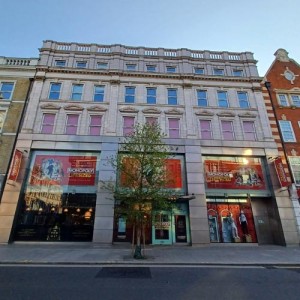 Another sign that the shape of retail and high streets are changing was the fact that the old Paperchase superstore on Tottenham Court Road is now the home of the Monopoly Lifesized live attraction.
Another sign that the shape of retail and high streets are changing was the fact that the old Paperchase superstore on Tottenham Court Road is now the home of the Monopoly Lifesized live attraction.
I was in London relatively early so it wasn’t open at the time of my visit, but it was interesting to see that it was sited on a shopping street rather than in a leisure complex or out of town.
Clearly landlords are looking for new uses for shop spaces, but also the dynamics of town centres are changing. There are more new housing developments with apartments and flats being built including office conversions.
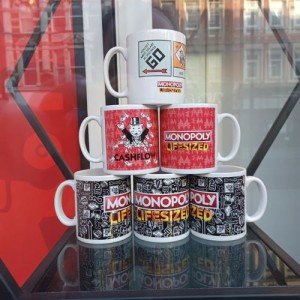 Monopoly Lifesized is a good example of IP being used in new and exciting ways in the experiential sector, but also a good example of how high streets are changing and indeed it may be a clue to how high streets may be revived with the introduction of feature spaces like this one.
Monopoly Lifesized is a good example of IP being used in new and exciting ways in the experiential sector, but also a good example of how high streets are changing and indeed it may be a clue to how high streets may be revived with the introduction of feature spaces like this one.
Interestingly, Monopoly Lifesized includes a retail shop and a dining space. The signs on the door make it clear that ‘everyone is welcome’. The site is a multi purpose one with eating, shopping and experience all housed under one roof. Again this is maybe a trend we will see more and more on the high street, with shop spaces having multi purpose functions as owners and operators adapt to new circumstances, but also seek to achieve maximum value from retail spaces.
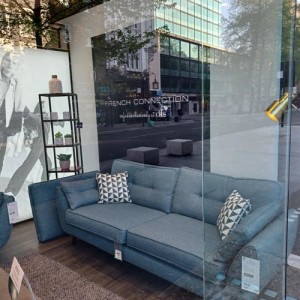 Returning to the theme of blended retail, it was also interesting to see fashion retailer French Connection featuring in the window of furniture retailer, DFS.
Returning to the theme of blended retail, it was also interesting to see fashion retailer French Connection featuring in the window of furniture retailer, DFS.
DFS has developed a range of French Connection sofas. This is a good example of how retail brands are being used in licensing outside their core areas, but also how retail brands are being more innovative about stretching their brands but doing it in a controlled way.
In this context, the licensing model allows French Connection to explore a category it thinks is relevant in a relatively low risk way and it literally gives them a new shop window on the high street at no obvious cost. It was also interesting to see that around 300 yards away on a side street that there was a 80% off RRP French Connection sample sale going on. Sample sales are, of course, quite common but seeing French Connection in these two retail settings so close to each other was a vivid reminder that the world of retail is a very complex and challenging one at the moment.
Retailers are having to be more open to a blended way of working, while it seems the high street is changing in shape and form. I think we all have to be more prepared for change and accepting that the ‘traditional’ retail model has been sold off. I think as the Monopoly Lifesized example in particular shows there is a good opportunity for licensing to play a significant part in this retail re-invention.
Ian Downes runs Start Licensing, an independent brand licensing agency. His Twitter handle is @startlicensing – he would welcome your suggestions for what to look out for.
































